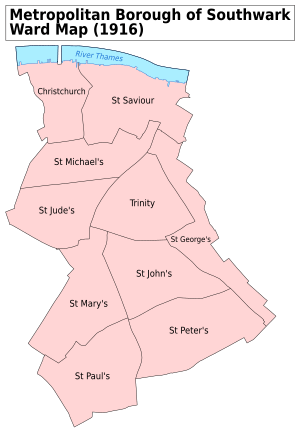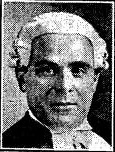Quick facts for kids {{{Name}}}
[[{{{Type}}} constituency]] |
[[Image:{{{Map1}}}Constituency.svg|120px|]]
[[Image:England{{{Map2}}}.svg|120px|]] |
| {{{Name}}} shown within [[{{{Entity}}}]], and {{{Entity}}} shown within England |
| Created: |
{{{Year}}} |
| MP: |
{{{MP}}} |
| Party: |
{{{Party}}} |
| Type: |
House of Commons |
| County: |
[[{{{County}}}]] |
| EP constituency: |
[[{{{EP}}} (European Parliament constituency)|{{{EP}}}]] |
Southwark (Br [ˈsʌðɨk]) South East was a parliamentary constituency in the Metropolitan Borough of Southwark, in South London. It returned one Member of Parliament (MP) to the House of Commons of the Parliament of the United Kingdom.

Southwark South East in the Parliamentary County of London, 1918-49

A map showing the wards of Southwark Metropolitan Borough as they appeared in 1916.
The constituency was created for the 1918 general election, and abolished for the 1950 general election, when it was largely replaced by the new Southwark constituency.
The constituency comprised the wards of St. George, St. John and St. Peter. It covered most of East Walworth and Faraday wards, together with a sliver of Grange ward, in the modern day London Borough of Southwark.
Members of Parliament
Elections
Elections in the 1910s
Elections in the 1920s
| 1921 Southwark South East by-election |
| Party |
Candidate |
Votes |
% |
±% |
|
Labour |
Thomas Naylor |
6,561 |
57.0 |
+29.6 |
|
National Liberal |
Thomas Owen Jacobsen |
2,636 |
22.9 |
-49.7 |
|
Ind U |
Horace Louis Petit Boot |
2,307 |
20.1 |
New |
| Majority |
3,925 |
34.1 |
N/A |
| Turnout |
11,504 |
38.5 |
-6.7 |
|
Labour gain from Coalition Liberal |
Swing |
+39.6 |
|
| General election 1922: Southwark South East |
| Party |
Candidate |
Votes |
% |
±% |
|
National Liberal |
Maurice Alexander |
10,014 |
56.4 |
N/A |
|
Labour |
Thomas Naylor |
7,734 |
43.6 |
+16.2 |
| Majority |
2,280 |
12.8 |
N/A |
| Turnout |
17,748 |
58.2 |
|
|
National Liberal gain from Labour |
Swing |
|
|
| General election 1923: Southwark South East |
| Party |
Candidate |
Votes |
% |
±% |
|
Labour |
Thomas Naylor |
9,374 |
54.3 |
+10.7 |
|
Liberal |
Maurice Alexander |
7,884 |
45.7 |
-10.7 |
| Majority |
1,490 |
8.6 |
N/A |
| Turnout |
17,258 |
55.7 |
-2.5 |
|
Labour gain from Liberal |
Swing |
+10.7 |
|
| General election 1929: Southwark South East |
| Party |
Candidate |
Votes |
% |
±% |
|
Labour |
Thomas Naylor |
13,527 |
60.4 |
+6.1 |
|
Liberal |
William John Squire |
4,766 |
21.3 |
+10.1 |
|
Unionist |
Evelyn George Harcourt Powell |
4,086 |
18.3 |
-16.2 |
| Majority |
8,761 |
39.1 |
+19.3 |
| Turnout |
22,379 |
58.9 |
-9.2 |
|
Labour hold |
Swing |
-2.0 |
|
Elections in the 1930s
| General election 1931: Southwark South East |
| Party |
Candidate |
Votes |
% |
±% |
|
Conservative |
Evelyn George Harcourt Powell |
11,063 |
53.3 |
+35.0 |
|
Labour |
Thomas Naylor |
9,678 |
46.7 |
-13.7 |
| Majority |
1,385 |
6.6 |
N/A |
| Turnout |
20,741 |
54.1 |
-4.8 |
|
Conservative gain from Labour |
Swing |
|
|
| General election 1935: Southwark South East |
| Party |
Candidate |
Votes |
% |
±% |
|
Labour |
Thomas Naylor |
11,942 |
63.2 |
+16.5 |
|
Conservative |
Evelyn George Harcourt Powell |
6,945 |
36.8 |
-16.5 |
| Majority |
4,997 |
26.4 |
+19.8 |
| Turnout |
18,887 |
53.3 |
-0.8 |
|
Labour gain from Conservative |
Swing |
|
|
General Election 1939–40
Another General Election was required to take place before the end of 1940. The political parties had been making preparations for an election to take place and by the Autumn of 1939, the following candidates had been selected;
- Labour: Thomas Naylor
- Conservative:
Elections in the 1940s
| General election 1945: Southwark South East |
| Party |
Candidate |
Votes |
% |
±% |
|
Labour |
Thomas Naylor |
9,599 |
76.9 |
+13.7 |
|
Conservative |
James Greenwood |
2,881 |
23.1 |
-13.7 |
| Majority |
6,718 |
53.8 |
+27.4 |
| Turnout |
12,480 |
60.8 |
+7.5 |
|
Labour hold |
Swing |
|
|







